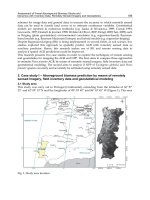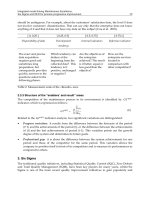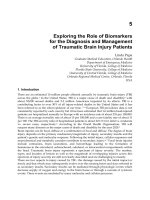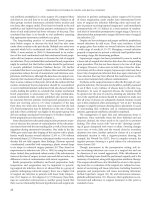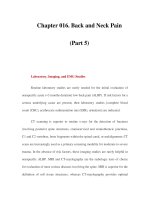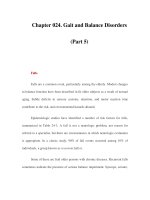Chapter 073. Enteral and Parenteral Nutrition (Part 5) potx
Bạn đang xem bản rút gọn của tài liệu. Xem và tải ngay bản đầy đủ của tài liệu tại đây (17.67 KB, 5 trang )
Chapter 073. Enteral and
Parenteral Nutrition
(Part 5)
Disease-Specific Nutritional Support
SNS is basically a support therapy and is primary therapy only for the
treatment or prevention of malnutrition. Certain conditions require modification of
nutritional support because of organ or system impairment. For instance, in
nitrogen accumulation disorders, protein intake may need to be reduced. However,
in renal disease, except for brief periods of several days, protein intakes should
approach requirement levels of at least 0.8 g/kg or higher up to 1.2 g/kg as long as
the blood urea nitrogen does not exceed 100 mg/dL. If this is not possible, then
dialysis or hemofiltration should be considered to allow better feeding. In hepatic
failure, intakes of 1.2–1.4 g/kg up to the optimal 1.5 g/kg should be attempted, as
long as encephalopathy due to protein intolerance is not encountered. In the
presence of protein intolerance, formulas containing 33–50% branched-chain
amino acids are available at the 1.2–1.4-g/kg level. Cardiac patients, and many
severely stressed patients, often benefit from fluid and sodium restriction to levels
of 1000 mL of total parenteral nutrition (TPN) formula and 5–20 meq of sodium
per day. In patients with severe chronic PCM characterized by severe weight loss
and tissue wasting, TPN must be instituted gradually because of the profound
antinatriuresis, antidiuresis, and intracellular accumulation of potassium,
magnesium, and phosphorus. This is usually accomplished by limiting fluid
intakes initially to about 1000 mL containing modest carbohydrate content of 10–
20% dextrose, low sodium, and ample potassium, magnesium, and phosphorus,
with careful assessment of fluid and electrolyte status. Protein need not be
restricted.[newpage]
The Design of Individual Regimens
Fluid Requirements
The normal daily requirement for fluid is 30 mL/kg of body weight from all
sources (IV infusions, per tube, or oral intake), plus any replacement of abnormal
losses such as an osmotic diuresis, nasogastric drainage, wound output, or
diarrheal/ostomy losses. Electrolyte and mineral losses can be estimated or
measured and also need to be replaced (Table 73-3). Fluid restriction may be
necessary in patients with fluid overload, and fluid inputs can be limited to 1200
mL/d if urine is the only significant fluid output. When severe fluid overload
occurs, the optimal PN solution for central venous administration is a concentrated
1-L solution of 7% crystalline amino acids (70 g) and 21% dextrose (210 g),
which provides an amount of nitrogen and glucose that is effective at protein-
sparing.
Table 73-3 Enteric Fluid Volumes and Their Electrolyte Content
a
L/
d
Na K Cl
HCO
3
H
Oral
intake
2–
3
Enteric
secretions
Saliva 1–
2
15 30
15
50 —
Gastric
juic
e
1.5
–2
50–
70
5–
15
90
–120
0 70
–100
Bile 0.5
–1.5
120
–150
5–
15
80
–120
30–
50
—
Pancreati
c
0.5
–1
100
–140
10
70
–100
60–
110
—
Small
intestine
1–
2
80–
140
10
–20
80
–120
20–
40
—
a
All in mEq/L.
Source: Adapted from previous chapter by Lyn Howard, MD, in Harrison's
Principles of Internal Medicine
Patients requiring PN or EN in the acute care setting generally have some
element of associated hormonal adaptations (e.g., increased secretion of
antidiuretic hormone, aldosterone, insulin, glucagon, or cortisol) that cause fluid
retention and hyperglycemia. Weight gain in the critically ill, whether receiving
SNS or not, is invariably the consequence of fluid retention, since lean tissue
accretion is minimal in the acute phase of illness. Because excess fluid removal
can be difficult, limiting fluid intake to allow for balanced intake and output is
more effective.


